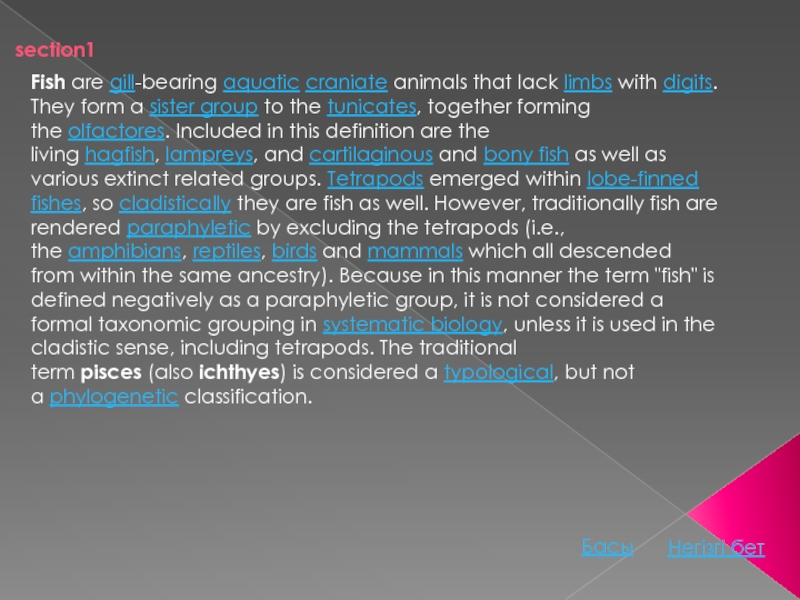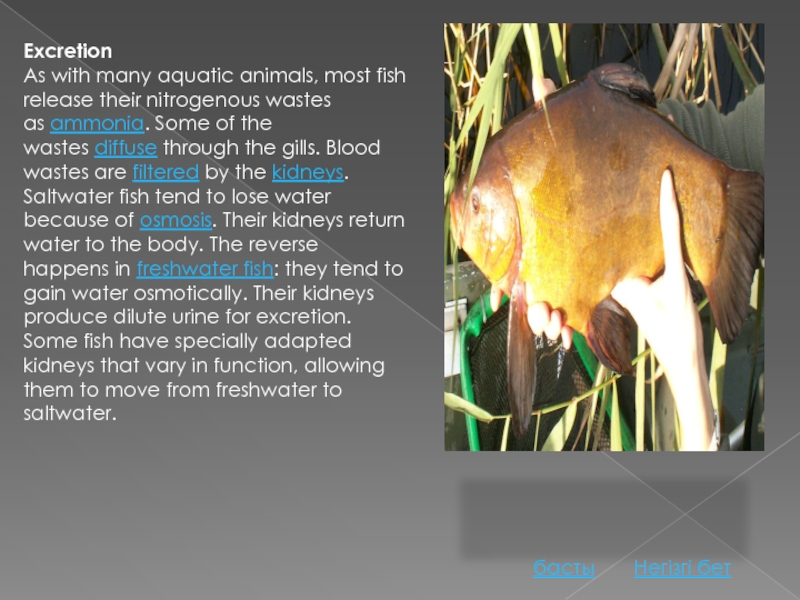Разделы презентаций
- Разное
- Английский язык
- Астрономия
- Алгебра
- Биология
- География
- Геометрия
- Детские презентации
- Информатика
- История
- Литература
- Математика
- Медицина
- Менеджмент
- Музыка
- МХК
- Немецкий язык
- ОБЖ
- Обществознание
- Окружающий мир
- Педагогика
- Русский язык
- Технология
- Физика
- Философия
- Химия
- Шаблоны, картинки для презентаций
- Экология
- Экономика
- Юриспруденция
Section1 section2 section3 section4 section5 implementation Nurpeisova
Содержание
- 1. Section1 section2 section3 section4 section5 implementation Nurpeisova
- 2. section1Негізгі бетБасыFish are gill-bearing aquatic craniate animals that lack limbs with digits. They form a sister
- 3. Негізгі бетGiant grouper swimming among schools of other fish
- 4. The earliest organisms that can be classified
- 5. Негізгі бетБасы … section2Fish can communicate in
- 6. Fish are abundant in most bodies of
- 7. section3Басты бетEvolutionMain article: Evolution of fishFish, as vertebrata,
- 8. Негізгі бетБасы …TaxonomyFish are a paraphyletic group:
- 9. Негізгі бетБасы …The above scheme is the
- 10. DiversityThe term "fish" most precisely describes any
- 11. section4Басты бетAnatomy and physiologyRespirationSee also: Aquatic respirationGillsMost fish
- 12. Air breathingPhoto of fish head split in
- 13. Tuna gills inside the head. The fish head
- 14. CirculationDidactic model of a fish heartFish have
- 15. DigestionJaws allow fish to eat a wide
- 16. ExcretionAs with many aquatic animals, most fish
- 17. section5Sensory and nervous systemCentral nervous systemFish typically
- 18. Sense organsMost fish possess highly developed sense
- 19. In this oblique view of a goldfish (Carrasius auratus),
- 20. VisionMain article: Vision in fishesVision is an important sensory system for
- 21. CognitionFurther information: Fish intelligenceNew research has expanded preconceptions
- 22. Capacity for painFurther information: Pain in fishExperiments done
- 23. Muscular systemMain article: Fish locomotionPhoto of white
- 24. Reproductive systemFurther information: Fish reproduction and Spawn
- 25. Immune systemImmune organs vary by type of
- 26. Shoal or schoolMain article: Shoaling and schoolingPhoto
- 27. Скачать презентанцию
Слайды и текст этой презентации
Слайд 1Section1
section2
section3
section4
section5
implementation Nurpeisova Nargiz
Group biology 2 course
Topic: Fish
Слайд 2section1
Негізгі бет
Басы
Fish are gill-bearing aquatic craniate animals that lack limbs with digits. They form a sister group to the tunicates, together
Слайд 4The earliest organisms that can be classified as fish were
soft-bodied chordates that first appeared during the Cambrian period. Although they lacked a true spine,
they possessed notochords which allowed them to be more agile than their invertebrate counterparts. Fish would continue to evolve through the Paleozoic era, diversifying into a wide variety of forms. Many fish of the Paleozoic developed external armor that protected them from predators. The first fish with jaws appeared in the Silurian period, after which many (such as sharks) became formidable marine predators rather than just the prey of arthropods.Most fish are ectothermic ("cold-blooded"), allowing their body temperatures to vary as ambient temperatures change, though some of the large active swimmers like white shark and tuna can hold a higher core temperature.
Негізгі бет
Басты бет
Слайд 5Негізгі бет
Басы …
section2
Fish can communicate in their underwater environments
through the use of acoustic communication. Acoustic communication in fish
involves the transmission of acoustic signals from one individual of a species to another. The production of sounds as a means of communication among fish is most often used in the context of feeding, aggression or courtship behaviour. The sounds emitted by fish can vary depending on the species and stimulus involved. They can produce either stridulatory sounds by moving components of the skeletal system, or can produce non-stridulatory sounds by manipulating specialized organs such as the swimbladder.Слайд 6Fish are abundant in most bodies of water. They can
be found in nearly all aquatic environments, from high mountain
streams (e.g., char and gudgeon) to the abyssal and even hadal depths of the deepest oceans (e.g., gulpers and anglerfish), although no species has yet been documented in the deepest 25% of the ocean. With 33,600 described species, fish exhibit greater species diversity than any other group of vertebrates.Fish are an important resource for humans worldwide, especially as food. Commercial and subsistence fishers hunt fish in wild fisheries (see fishing) or farm them in ponds or in cages in the ocean (see aquaculture). They are also caught by recreational fishers, kept as pets, raised by fishkeepers, and exhibited in public aquaria. Fish have had a role in culture through the ages, serving as deities, religious symbols, and as the subjects of art, books and movies.Басты бет
Негізгі бет
Слайд 7section3
Басты бет
Evolution
Main article: Evolution of fish
Fish, as vertebrata, developed as sister
of the tunicata. As the tetrapods emerged deep within the
fishes group, as sister of the lungfish, characteristics of fish are typically shared by tetrapods, including having vertebrae and a cranium.Dunkleosteus was a gigantic, 10-metre (33 ft) long prehistoric fish of class Placodermi.
Early fish from the fossil record are represented by a group of small, jawless, armored fish known as ostracoderms. Jawless fish lineages are mostly extinct. An extant clade, the lampreys may approximate ancient pre-jawed fish. The first jaws are found in Placodermi fossils. The diversity of jawed vertebrates may indicate the evolutionary advantage of a jawed mouth. It is unclear if the advantage of a hinged jaw is greater biting force, improved respiration, or a combination of factors.
Fish may have evolved from a creature similar to a coral-like sea squirt, whose larvae resemble primitive fish in important ways. The first ancestors of fish may have kept the larval form into adulthood (as some sea squirts do today), although perhaps the reverse is the case.
Слайд 8Негізгі бет
Басы …
Taxonomy
Fish are a paraphyletic group: that is, any
clade containing all fish also contains the tetrapods, which are
not fish. For this reason, groups such as the class Pisces seen in older reference works are no longer used in formal classifications.Leedsichthys (left), of the subclass Actinopterygii, is the largest known fish, with estimates in 2005 putting its maximum size at 16 metres (52 ft).
Traditional classification divides fish into three extant classes, and with extinct forms sometimes classified within the tree, sometimes as their own classes.
Слайд 9Негізгі бет
Басы …
The above scheme is the one most commonly
encountered in non-specialist and general works. Many of the above
groups are paraphyletic, in that they have given rise to successive groups: Agnathans are ancestral to Chondrichthyes, who again have given rise to Acanthodiians, the ancestors of Osteichthyes. With the arrival of phylogenetic nomenclature, the fishes has been split up into a more detailed scheme, with the following major groups.Chondrichthyes
(Horn shark)
Слайд 10Diversity
The term "fish" most precisely describes any non-tetrapod craniate (i.e. an animal
with a skull and in most cases a backbone) that
has gills throughout life and whose limbs, if any, are in the shape of fins. Unlike groupings such as birds or mammals, fish are not a single clade but a paraphyletic collection of taxa, including hagfishes, lampreys, sharks and rays, ray-finned fish, coelacanths, and lungfish.[18][19] Indeed, lungfish and coelacanths are closer relatives of tetrapods (such as mammals, birds, amphibians, etc.) than of other fish such as ray-finned fish or sharks, so the last common ancestor of all fish is also an ancestor to tetrapods. As paraphyletic groups are no longer recognised in modern systematic biology, the use of the term "fish" as a biological group must be avoided.Agnatha
(Pacific hagfish)
басы
Негізгі бет
Слайд 11section4
Басты бет
Anatomy and physiology
Respiration
See also: Aquatic respiration
Gills
Most fish exchange gases using gills on
either side of the pharynx. Gills consist of threadlike structures called filaments.
Each filament contains a capillary network that provides a large surface area for exchanging oxygen and carbon dioxide. Fish exchange gases by pulling oxygen-rich water through their mouths and pumping it over their gills. In some fish, capillary blood flows in the opposite direction to the water, causing countercurrent exchange. The gills push the oxygen-poor water out through openings in the sides of the pharynx. Some fish, like sharks and lampreys, possess multiple gill openings. However, bony fish have a single gill opening on each side. This opening is hidden beneath a protective bony cover called an operculum.Juvenile bichirs have external gills, a very primitive feature that they share with larval amphibians.
Слайд 12Air breathing
Photo of fish head split in half longitudinally with
gill filaments crossing from top to bottom
Tuna gills inside the
head. The fish head is oriented snout-downwards, with the view looking towards the mouth.Fish from multiple groups can live out of the water for extended periods. Amphibious fish such as the mudskipper can live and move about on land for up to several days,[dubious – discuss] or live in stagnant or otherwise oxygen depleted water. Many such fish can breathe air via a variety of mechanisms. The skin of anguillid eels may absorb oxygen directly. The buccal cavity of the electric eel may breathe air. Catfish of the families Loricariidae, Callichthyidae, and Scoloplacidae absorb air through their digestive tracts.[30] Lungfish, with the exception of the Australian lungfish, and bichirs have paired lungs similar to those of tetrapods and must surface to gulp fresh air through the mouth and pass spent air out through the gills. Gar and bowfin have a vascularized swim bladder that functions in the same way. Loaches, trahiras, and many catfish breathe by passing air through the gut. Mudskippers breathe by absorbing oxygen across the skin (similar to frogs). A number of fish have evolved so-called accessory breathing organs that extract oxygen from the air. Labyrinth fish (such as gouramis and bettas) have a labyrinth organ above the gills that performs this function. A few other fish have structures resembling labyrinth organs in form and function, most notably snakeheads, pikeheads, and the Clariidae catfish family.
Басты бет
Негізгі бет
Слайд 13Tuna gills inside the head. The fish head is oriented snout-downwards,
with the view looking towards the mouth.
Басты бет
Негізгі бет
Слайд 14Circulation
Didactic model of a fish heart
Fish have a closed-loop circulatory
system. The heart pumps the blood in a single loop
throughout the body. In most fish, the heart consists of four parts, including two chambers and an entrance and exit.[31] The first part is the sinus venosus, a thin-walled sac that collects blood from the fish's veins before allowing it to flow to the second part, the atrium, which is a large muscular chamber. The atrium serves as a one-way antechamber, sends blood to the third part, ventricle. The ventricle is another thick-walled, muscular chamber and it pumps the blood, first to the fourth part, bulbus arteriosus, a large tube, and then out of the heart. The bulbus arteriosus connects to the aorta, through which blood flows to the gills for oxygenation.басты
Негізгі бет
Слайд 15Digestion
Jaws allow fish to eat a wide variety of food,
including plants and other organisms. Fish ingest food through the
mouth and break it down in the esophagus. In the stomach, food is further digested and, in many fish, processed in finger-shaped pouches called pyloric caeca, which secrete digestive enzymes and absorb nutrients. Organs such as the liver and pancreas add enzymes and various chemicals as the food moves through the digestive tract. The intestine completes the process of digestion and nutrient absorption.басты
Негізгі бет
Слайд 16Excretion
As with many aquatic animals, most fish release their nitrogenous
wastes as ammonia. Some of the wastes diffuse through the gills. Blood wastes
are filtered by the kidneys.Saltwater fish tend to lose water because of osmosis. Their kidneys return water to the body. The reverse happens in freshwater fish: they tend to gain water osmotically. Their kidneys produce dilute urine for excretion. Some fish have specially adapted kidneys that vary in function, allowing them to move from freshwater to saltwater.
басты
Негізгі бет
Слайд 17section5
Sensory and nervous system
Central nervous system
Fish typically have quite small
brains relative to body size compared with other vertebrates, typically
one-fifteenth the brain mass of a similarly sized bird or mammal. However, some fish have relatively large brains, most notably mormyrids and sharks, which have brains about as massive relative to body weight as birds and marsupials.Fish brains are divided into several regions. At the front are the olfactory lobes, a pair of structures that receive and process signals from the nostrilsvia the two olfactory nerves.The olfactory lobes are very large in fish that hunt primarily by smell, such as hagfish, sharks, and catfish. Behind the olfactory lobes is the two-lobed telencephalon, the structural equivalent to the cerebrum in higher vertebrates. In fish the telencephalon is concerned mostly with olfaction.Together these structures form the forebrain.
Connecting the forebrain to the midbrain is the diencephalon (in the diagram, this structure is below the optic lobes and consequently not visible). The diencephalon performs functions associated with hormones and homeostasis. The pineal body lies just above the diencephalon. This structure detects light, maintains circadian rhythms, and controls color changes.
басты
Негізгі бет
Слайд 18Sense organs
Most fish possess highly developed sense organs. Nearly all
daylight fish have color vision that is at least as
good as a human's (see vision in fishes). Many fish also have chemoreceptors that are responsible for extraordinary senses of taste and smell. Although they have ears, many fish may not hear very well. Most fish have sensitive receptors that form the lateral line system, which detects gentle currents and vibrations, and senses the motion of nearby fish and prey. Some fish, such as catfish and sharks, have the Ampullae of Lorenzini, organs that detect weak electric currents on the order of millivolt. Other fish, like the South American electric fishes Gymnotiformes, can produce weak electric currents, which they use in navigation and social communication.Fish orient themselves using landmarks and may use mental maps based on multiple landmarks or symbols. Fish behavior in mazes reveals that they possess spatial memory and visual discrimination.
басты
Негізгі бет
Слайд 19In this oblique view of a goldfish (Carrasius auratus), some of the
pored scales of the lateral line system are visible.
басты
Негізгі бет
Слайд 20Vision
Main article: Vision in fishes
Vision is an important sensory system for most species of
fish. Fish eyes are similar to those of terrestrial vertebrates like birds and mammals, but
have a more spherical lens. Their retinas generally have both rods and cones (for scotopic and photopic vision), and most species have colour vision. Some fish can see ultraviolet and some can see polarized light. Amongst jawless fish, the lamprey has well-developed eyes, while the hagfish has only primitive eyespots.[37] Fish vision shows adaptation to their visual environment, for example deep sea fishes have eyes suited to the dark environment.басы
Негізгі бет
Слайд 21Cognition
Further information: Fish intelligence
New research has expanded preconceptions about the cognitive
capacities of fish. For example, manta rays have exhibited behavior linked to self-awareness in mirror
test cases. Placed in front of a mirror, individual rays engaged in contingency testing, that is, repetitive behavior aiming to check whether their reflection's behavior mimics their body movement.Wrasses have also passed the mirror test in a 2018 scientific study.Cases of tool use have also been noticed, notably in the Choerodon family, in archerfish and Atlantic cod.
басы
Негізгі бет
Слайд 22Capacity for pain
Further information: Pain in fish
Experiments done by William Tavolga
provide evidence that fish have pain and fear responses. For instance, in
Tavolga's experiments, toadfish grunted when electrically shocked and over time they came to grunt at the mere sight of an electrode.In 2003, Scottish scientists at the University of Edinburgh and the Roslin Institute concluded that rainbow trout exhibit behaviors often associated with pain in other animals. Beevenom and acetic acid injected into the lips resulted in fish rocking their bodies and rubbing their lips along the sides and floors of their tanks, which the researchers concluded were attempts to relieve pain, similar to what mammals would do.Neurons fired in a pattern resembling human neuronal patterns.
басы
Негізгі бет
Слайд 23Muscular system
Main article: Fish locomotion
Photo of white bladder that consists
of a rectangular section and a banana-shaped section connected by
a much thinner elementSwim bladder of a rudd (Scardinius erythrophthalmus)
Most fish move by alternately contracting paired sets of muscles on either side of the backbone. These contractions form S-shaped curves that move down the body. As each curve reaches the back fin, backward force is applied to the water, and in conjunction with the fins, moves the fish forward. The fish's fins function like an airplane's flaps. Fins also increase the tail's surface area, increasing speed. The streamlined body of the fish decreases the amount of friction from the water. Since body tissue is denser than water, fish must compensate for the difference or they will sink. Many bony fish have an internal organ called a swim bladder that adjusts their buoyancy through manipulation of gases.
басты
Негізгі бет
Слайд 24Reproductive system
Further information: Fish reproduction and Spawn (biology)
Organs: 1. Liver,
2. Gas bladder, 3. Roe, 4. Pyloric caeca, 5. Stomach,
6. IntestineFish reproductive organs include testicles and ovaries. In most species, gonads are paired organs of similar size, which can be partially or totally fused.[51] There may also be a range of secondary organs that increase reproductive fitness.
In terms of spermatogonia distribution, the structure of teleosts testes has two types: in the most common, spermatogonia occur all along the seminiferous tubules, while in atherinomorph fish they are confined to the distal portion of these structures. Fish can present cystic or semi-cystic spermatogenesis in relation to the release phase of germ cells in cysts to the seminiferous tubules lumen.
басты
Негізгі бет
Слайд 25Immune system
Immune organs vary by type of fish.[67] In the
jawless fish (lampreys and hagfish), true lymphoid organs are absent.
These fish rely on regions of lymphoid tissue within other organs to produce immune cells. For example, erythrocytes, macrophages and plasma cells are produced in the anterior kidney (or pronephros) and some areas of the gut (where granulocytes mature.) They resemble primitive bone marrow in hagfish. Cartilaginous fish (sharks and rays) have a more advanced immune system. They have three specialized organs that are unique to Chondrichthyes; the epigonal organs (lymphoid tissue similar to mammalian bone) that surround the gonads, the Leydig's organ within the walls of their esophagus, and a spiral valve in their intestine. These organs house typical immune cells (granulocytes, lymphocytes and plasma cells). They also possess an identifiable thymus and a well-developed spleen (their most important immune organ) where various lymphocytes, plasma cells and macrophages develop and are stored. Chondrostean fish (sturgeons, paddlefish, and bichirs) possess a major site for the production of granulocytes within a mass that is associated with the meninges (membranes surrounding the central nervous system.) Their heart is frequently covered with tissue that contains lymphocytes, reticular cells and a small number of macrophages. The chondrostean kidney is an important hemopoietic organ; where erythrocytes, granulocytes, lymphocytes and macrophages develop.басты
Негізгі бет
Слайд 26Shoal or school
Main article: Shoaling and schooling
Photo of thousands of
fish separated from each other by distances of 2 inches
(51 mm) or lessThese goldband fusiliers are schooling because their swimming is synchronised.
A random assemblage of fish merely using some localised resource such as food or nesting sites is known simply as an aggregation. When fish come together in an interactive, social grouping, then they may be forming either a shoal or a school depending on the degree of organisation. A shoal is a loosely organised group where each fish swims and forages independently but is attracted to other members of the group and adjusts its behaviour, such as swimming speed, so that it remains close to the other members of the group. Schools of fish are much more tightly organised, synchronising their swimming so that all fish move at the same speed and in the same direction. Shoaling and schooling behaviour is believed to provide a variety of advantages.
























![Section1
section2
section3
section4
section5
implementation Nurpeisova Immune systemImmune organs vary by type of fish.[67] In the jawless Immune systemImmune organs vary by type of fish.[67] In the jawless fish (lampreys and hagfish), true lymphoid](/img/thumbs/aa8f5d35f758491b43a7f8932aeb598d-800x.jpg)




















